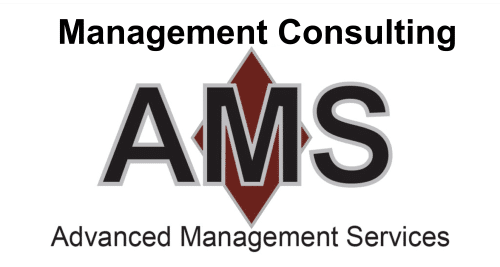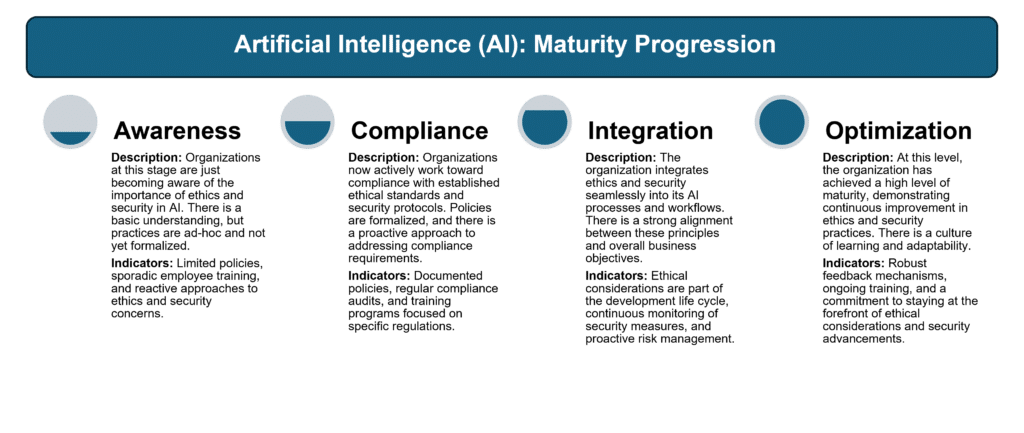Artificial Intelligence (AI): Organizational Roadmap
This consulting solution will help you to design an Artificial Intelligence (AI): Organizational Roadmap model.
The AMS Artificial Intelligence (AI): Organizational Roadmap is a comprehensive approach to AI deployment that ensures strategic alignment, ethical integrity, and security. By embedding ethical and security considerations into each stage of the AI development and implementation process, organizations can achieve sustainable growth and maintain high standards that support their core values. This holistic approach not only maximizes the value of AI initiatives but builds trust and accountability while positioning organizations as leaders in responsible AI deployment. AMS will leverage their deep understanding of Organizational Development best practices to ensure continuity with the strategic plan. By using the Artificial Intelligence (AI): Organizational Assessment as a tool to baseline maturity and set a pathway for measured AI implementation, they offer clients a clear development plan for success.
Artificial Intelligence (AI): Organizational Roadmap
The Artificial Intelligence (AI): Organizational Roadmap is enabled by a maturity progression that will keep your AI integration on target and allow for clarity across the enterprise during AI implementation. This maturity model is predicated on the application of our proprietary Artificial Intelligence (AI): Organizational Assessment to baseline the starting point of your journey:
Key Features of the Artificial Intelligence (AI): Organizational Roadmap
Include
- AMS experts collaborate to help guide you on the journey.
- The roadmap places ethics front and center, ensuring that your organization operates with the highest standards of integrity.
- Our roadmap incorporates cutting-edge security measures, safeguarding your data and intellectual property with utmost precision.
- Seamless integration into your existing technology framework, fostering collaboration, and boosting operational efficiency.
- Departmental customization to serve each LoB, department, and/or practice area within the enterprise.
- Employee training to educate employees how AI impacts, interacts, and supports their daily functions at a skill-set level.
Benefits:
- Minimizes risks associated with data breaches and ethical lapses, safeguarding your brand reputation.
- By instilling a culture of ethics and security, you become a catalyst for innovation, driving sustainable growth.
- Employee well-being is prioritized with a model that ensures a secure and ethical work environment.
- Market and business continuity is enhanced by assessing and benchmarking your maturity of AI development you gain higher control of the application usage.
- Enhanced skills for AI Integration are achieved by teaching employees how "people" skills align to and are integrated with AI to generate more productivity.
Implementation Methodology
AMS will lead you through a seamless integration process, guaranteeing a smooth transition towards a future where ethics and security are seamlessly woven into the essence of your AI platform and cultural norms.
- Assess - your organization using our proprietary Artificial Intelligence (AI): Organizational Assessment measured against a benchmarked index of Best Practices.
- Review - the assessment results to determine your organizations maturity level and create a path forward progression roadmap.
- Execute - the roadmap deliverables to begin your maturity progression journey.
Modeling Implementation Considerations
Our team will guide you along the journey leveraging a methodical approach to filling the gaps identified between your current and future state analysis. This process allows for collaboration, knowledge transfer and flexibility along the way, ensuring your AI and Humna Confluence impact points are addressed with the highest level of customized care.
Ethical Development Guidelines:
-
- The model begins with clear guidelines for the ethical development of AI technologies. This involves defining ethical principles that align with the values and goals of the organization.
Ethical Considerations in AI Deployment:
-
- During the deployment phase, the model emphasizes ongoing ethical considerations. This includes monitoring AI systems for biases, fairness, and transparency, ensuring that the technology aligns with ethical standards.
Continuous Ethical Training:
-
- To keep all stakeholders informed and aligned with ethical standards, the model includes a component for continuous ethical training. This involves educating developers, operators, and decision-makers about the latest ethical considerations in AI.
Security-by-Design Principles:
-
- Security is embedded throughout the development lifecycle with security-by-design principles. The model ensures that security measures are considered from the initial stages of AI development, reducing vulnerabilities and potential risks.
Regular Security Audits and Updates:
-
- The model advocates for regular security audits to identify and address potential vulnerabilities. Continuous monitoring and updates are crucial to adapting to evolving security threats.
User Privacy Protection:
-
- Protecting user privacy is a central element of the model. It includes implementing robust data protection measures, obtaining informed consent, and ensuring that AI systems adhere to relevant privacy regulations.
Cross-Functional Collaboration:
-
- The model promotes cross-functional collaboration, encouraging communication between ethical, security, and technical teams. This ensures that all aspects are considered throughout the AI lifecycle.
Stakeholder Engagement:
-
- Engaging stakeholders, including employees, customers, and the wider community, is essential. The model emphasizes transparent communication and collaboration with stakeholders to build trust.
Feedback Mechanisms:
-
- Establishing feedback mechanisms allows for continuous improvement. Users and stakeholders are encouraged to provide feedback on ethical and security aspects, contributing to the refinement of AI systems.
Adherence to Ethical Standards and Regulations:
-
- The model ensures that AI implementations adhere to ethical standards and relevant regulations. This includes staying informed about legal frameworks and industry-specific guidelines.
Identify Key Opportunity Areas
Start by identifying the main areas where AI can create significant value for the organization. Common areas include:
- Operational Efficiency: Automating repetitive tasks, optimizing resource use, and improving supply chain management.
- Customer Experience: Personalized marketing, customer service chatbots, predictive analytics.
- Product and Service Innovation: Developing new AI-driven products and enhancing existing products with AI capabilities.
- Risk Management: Fraud detection, predictive maintenance, compliance monitoring.
- Data Insights: Advanced data analytics, real-time data processing, and decision-making support.
Define Strategic Goals
Clearly outline the strategic goals for each opportunity area. These goals should align with the organization's overall objectives. Examples include:
- Operational Efficiency: Reduce operational costs by 20% through process automation.
- Customer Experience: Increase customer satisfaction scores by 15% using AI-driven personalization.
- Product and Service Innovation: Launch two new AI-driven products within the next 12 months.
- Risk Management: Decrease fraud incidents by 30% with AI-based detection systems.
- Data Insights: Enhance decision-making accuracy by 25% with real-time analytics.
Map AI Solutions to Opportunity Areas
For each identified opportunity area, map specific AI solutions that can help achieve the strategic goals. This involves selecting appropriate AI technologies and tools.
Examples:
Operational Efficiency:
-
- AI Solution: Robotic Process Automation (RPA)
- Tool: UiPath, Blue Prism
- Goal: Automate invoice processing to reduce manual effort.
Customer Experience:
-
- AI Solution: Customer Service Chatbot
- Tool: IBM Watson, Dialogflow
- Goal: Provide 24/7 customer support and reduce response times.
Product and Service Innovation:
-
- AI Solution: Machine Learning for Product Recommendations
- Tool: TensorFlow, Scikit-learn
- Goal: Increase upsell and cross-sell opportunities on the e-commerce platform.
Risk Management:
-
- AI Solution: Predictive Maintenance
- Tool: Azure Machine Learning, AWS SageMaker
- Goal: Predict equipment failures and reduce downtime.
Data Insights:
-
- AI Solution: Real-Time Data Analytics
- Tool: Apache Kafka, Spark
- Goal: Provide real-time insights for marketing campaigns.
Develop an Implementation Roadmap
Create a detailed implementation roadmap that outlines the steps needed to deploy the AI solutions. This includes:
-
- Project Planning: Define project scope, timeline, and resources.
- Data Collection: Gather and preprocess the necessary data.
- Model Development: Develop and train AI models.
- Integration: Integrate AI solutions with existing systems.
- Testing: Conduct testing and validation.
- Deployment: Deploy AI solutions into the production environment.
- Monitoring: Set up monitoring and maintenance processes.
Measure and Optimize
Establish metrics and KPIs to measure the success of AI initiatives. Regularly review performance and optimize AI models and processes as needed.
Example Metrics:
- Operational Efficiency: Cost savings, process cycle time reduction.
- Customer Experience: Customer satisfaction scores, response time.
- Product and Service Innovation: Number of new products, revenue generated.
- Risk Management: Number of fraud incidents, downtime reduction.
- Data Insights: Decision-making accuracy, speed of insights.
Model Risks and Assumptions
- Ethical Dilemmas: The lack of a systematic ethical framework may lead to the unintentional development of AI systems that compromise user privacy, perpetuate biases, or infringe upon ethical norms.
- Security Vulnerabilities: Failing to integrate security measures throughout the AI lifecycle can result in vulnerabilities that malicious actors may exploit. This includes potential breaches, data leaks, and unauthorized access.
- Regulatory Non-Compliance: As governments and regulatory bodies increasingly focus on AI governance, organizations may find themselves non-compliant with evolving standards and regulations related to ethical AI development and data security.
- Reputational Damage: Incidents of ethical misconduct or security breaches can severely damage an organization's reputation. Trust is paramount in the AI landscape, and public perception can be significantly impacted by lapses in ethical or security considerations.
- Operational Disruptions: Security incidents or ethical controversies can disrupt regular operations, leading to financial losses, legal complications, and a loss of stakeholder confidence.
- Missed Innovation Opportunities: Organizations may miss out on valuable opportunities for innovation if they do not proactively embrace ethical and secure AI practices. Potential stakeholders, including customers, investors, and partners, may seek out organizations with a more responsible approach to AI.
Summary
At AMS, we recognize that triumph in today's ever-changing business environment demands more than conventional consulting approaches. The Artificial Intelligence (AI): Organizational Roadmap outlines an AI strategy that guarantees alignment among people, processes, technology, and the organization to uphold overarching objectives within your core values. Contact Us today to arrange a discussion with our AI team and we also encourage you to view a recent Thought Leader Interview for an overview of the Model. Watch the Video>
Consulting & Training That Defies Limits & Inspires Growth.
Join the ranks of leading organizations that have partnered with AMS to drive innovation, improve performance, and achieve sustainable success. Let’s transform together, your journey to excellence starts here.

